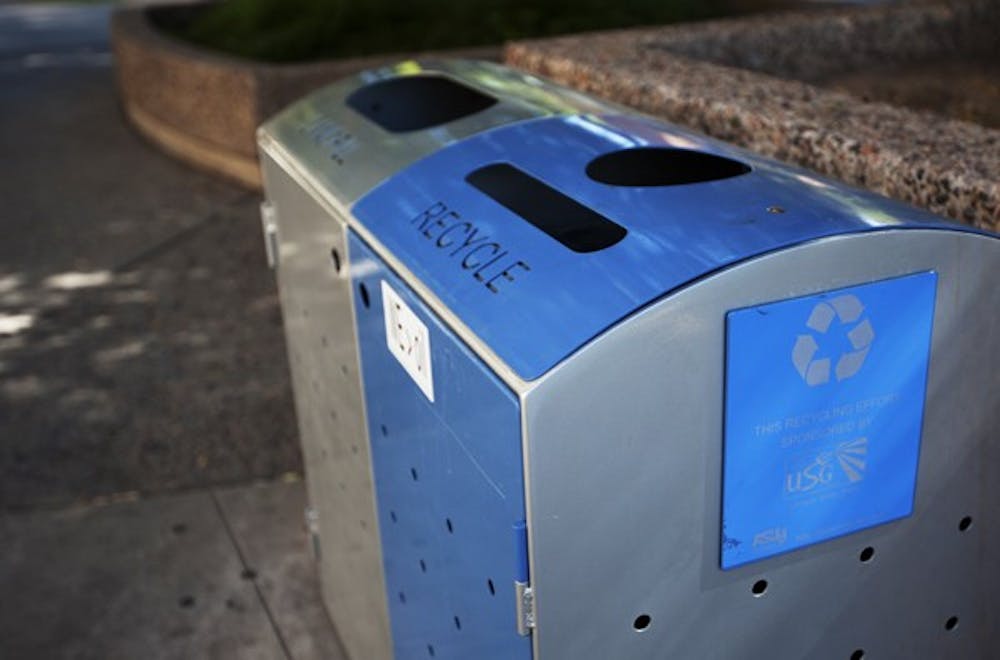 For two months, ASU registered an average recycling rate of 25 percent a week. These recycling bins are seen throughout the campus attached to a garbage can. (Photo by Perla Farais)
For two months, ASU registered an average recycling rate of 25 percent a week. These recycling bins are seen throughout the campus attached to a garbage can. (Photo by Perla Farais)From Feb. 3 to March 30, ASU registered an average recycling rate of 25 percent of its waste — an equivalent of 874 metric tons of carbon dioxide or 76 households’ energy consumption. However, it ranked in the middle of the pack compared to other universities.
The rate was recorded along with the rates of 523 universities at this year’s RecycleMania, an eight-week tournament that aims to increase waste-management practices.
The tournament’s grand champion category of recycling rate pitted 274 competitors for the title. ASU was No. 162, while the University of Missouri in Kansas City was crowned the winner.
RecycleMania spokesman Alec Cooley said the competition began 13 years ago as a challenge between two schools — Ohio University and Miami University — and quickly grew to include hundreds of universities and colleges in the U.S.
Cooley said the tournament’s objective is to initiate recycling and conservation among the students, and to make campus recycling programs more visible.
“(RecycleMania) is about developing recycling habits with students on campus,” he said.
Cooley and the the RecycleMania team spend a lot of time working on coming up with a way to count the recycling rate at each school. Every school has a different system, but the team provides basic guidelines on how schools should track their recycling, Cooley said.
The universities report to RecycleMania the amount of trash they have and how much of that is recycled to obtain the percentage of minimal waste, he said.
“It’s fun to see which school does best, but at the end of the day, this is about students making action and really embracing recycling and conservation,” he said. “We hope that after the competition is over, students are integrating recycling into their everyday activities.”
Lucas Mariacher, a recycling technician at ASU, said the University employs a commingled system to encourage more students to recycle. A commingled system combines papers, plastic, glass and aluminum in a single bin.
“It helps a lot with our recycling rates,” he said. “It eliminates the thought process for the user so they can just throw it all out in one bin.”
The current recycling rate on the Tempe campus is around 30 percent, Mariacher said. The University aims to accomplish the goal of zero waste by 2015, he said.
This rate was at 18 percent when Mariacher and the rest of ASU Recycling team started working on campus in 2011. The team of only five has a long way to go, he said.
“We’re doing a lot better than we were,” he said.
The recycling team at ASU works with the Ground Services department. The department recently started collecting coffee grounds from the Starbucks locations on campus and is reusing it as fertilizer.
This initiative will reduce a lot of waste, Mariacher said.
The team launched new branding at the beginning of the semester and its website is still in the beta stage. To encourage more students to recycle and compost, the team hosts a table event at every farmers market on the Tempe campus.
“It’s hard to compare (ASU) with other universities, but for the size of our University, we’re doing a good job,” he said. “In the next few years, we’ll only get better.”
Business junior Justin Fleming said the commingled system makes it easier for the average person to recycle, but he would still recycle even if it meant using more than one bin.
Fleming said he always recycles his waste and thinks ASU does a good job of encouraging students to recycle.
“I don’t know what else they could do,” he said. “When it boils down to it, they can put out the bins, but it’s up to the individuals whether they use it or not.”
Accounting and finance senior Yangnizi Chen said most people don’t want to take the time to separate their waste, so it is a good strategy to have only one blue recycling bin.
Chen said the recycling bins were very easily identified and the University had done a good job putting one next to every trash bin on campus.
“It’s very easy,” she said. “Although I’ve seen many people put their trash in recycling cans. Some people just don’t want to do it.”
Reach the reporter at dpbaltaz@asu.edu or follow her on Twitter @dpalomabp




